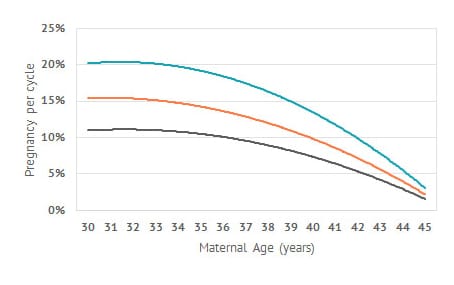Many indicators can be interpreted to determine your chances of getting pregnant. While some of these indicators require testing by a physician to evaluate, there is one that can be easily used to determine your chances of getting pregnant right now… your age.
Age is a very important indicator used to determine a woman’s chances of getting pregnant. In addition, the combination of age and the length of time trying to conceive provides insight into when to seek a fertility evaluation.
Medical contribution by Pavna Brahma, M.D.
Pavna K. Brahma, M.D., FACOG, is board certified in obstetrics and gynecology and reproductive endocrinology and infertility. She serves as SGF Atlanta’s IVF Director. Dr. Brahma sees patients at SGF’s Buckhead – Piedmont and Atlanta – Northside, Georgia offices.
Chances of getting pregnant by age
At birth, women will have their entire lifetime supply of eggs. As women age, the quality and quantity of those eggs begins to decrease. This, paired with the fact that human reproduction is not the most efficient process, makes timing key.
Many are surprised to learn that each month, on average, a woman only has a 15 to 20 percent chance of conception. For women in their 20s, their chances of getting pregnant within 1 year are 78 to 86 percent. For women 30 to 34, their chances of getting pregnant within 1 year is approximately 63 percent. For women ages 35 to 39, the chances of conception within 1 year declines to 52 percent. This rate continues to decline in a woman’s 40s, until she reaches menopause, typically between ages 48 and 55.
This is not to say that after 12 months of trying, conception magically declines, but rather that most fertile couples will have conceived, and couples who have not may likely have some form of infertility.
| Woman’s Age | % Conceiving in 12 Months | ||
| 20 to 24 years old | 86% | ||
| 25 to 29 years old | 78% | ||
| 30 to 34 years old | 63% | ||
| 35 to 39 years old | 52% |
By accounting for age-related declines in egg quality and quantity, your reproductive endocrinologist can personalize your initial evaluation. Infertility is generally defined as the inability to conceive within 12 months for women under the age of 35, and within 6 months for those over the age of 35.
Making an informed decision: when to see a fertility specialist
When thinking about your fertility options, your age can empower you to take proactive steps in your family building. Women under the age of 35 who have been trying for a year (or over 35 that have been trying for 6 months), should talk with a reproductive endocrinologist.
Shady Grove Fertility’s team of highly renowned reproductive endocrinologists are available for consultations to review medical history and advise if you need a fertility evaluation. Talking with a fertility specialist can provide you with the answers you need and help you understand why getting pregnant is taking longer than expected.
Which fertility treatment to consider
The outcomes of fertility treatments vary based on a woman’s age. Because the chances of success begin to decrease with age, taking the proactive step of talking to a fertility specialist as soon as you suspect a problem is important.
Chances of getting pregnant with intrauterine insemination (IUI)
For many women, in vitro fertilization (IVF) will likely not be their first treatment option. In fact, half of all treatment performed at Shady Grove Fertility is a more basic form of intervention called intrauterine insemination or IUI. The goal of this treatment is to increase the number of sperm that reach the Fallopian tubes and subsequently increases the chance of fertilization. IUI provides the sperm an advantage by giving it a head start, but still requires the sperm to reach and fertilize the egg on its own.
The goal of IUI treatment is to improve the rate of conception to that of the fertile population, or roughly 15 to 20 percent per attempt. Age, along with the cause of infertility, will ultimately determine what your chances of success are per cycle of IUI.

Chances of getting pregnant with in vitro fertilization (IVF)
IVF is one of the most widely talked about forms of fertility treatment because of its high success rates and significant technological advances. During IVF treatment, a physician will remove one or more eggs from the ovaries, which are then fertilized by sperm inside the embryology laboratory. The embryos develop, typically for 5 or 6 days, and then one or two embryos are then transferred into the uterus where implantation occurs, and pregnancy starts.
| <35 | 35-37 | 38-40 | 41-42 | >42 | |
| Initiated Cycles | 1522 | 974 | 1033 | 575 | 313 |
| Egg Retrievals (ER) | 1447 | 885 | 923 | 488 | 264 |
| Embryo Transfers (ET) | 1296 | 724 | 662 | 301 | 162 |
| Clinical Pregnancy rate per Embryo Transfer | 53.9% | 49% | 45.3% | 37.5% | 21% |







